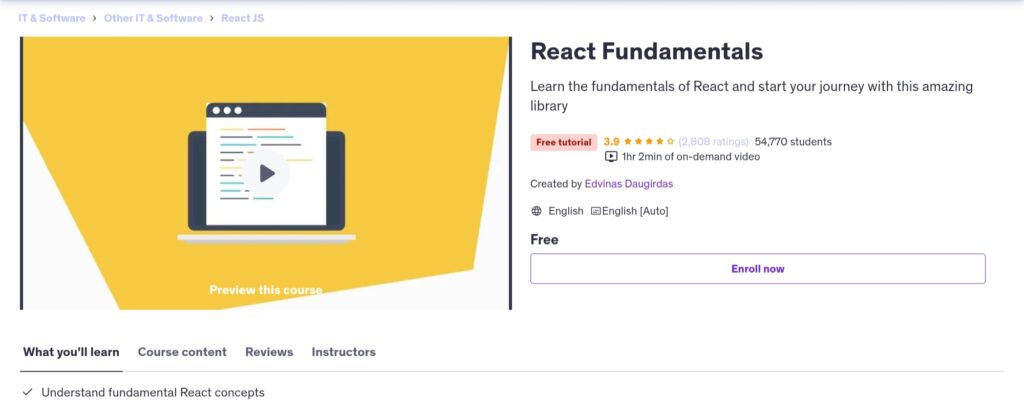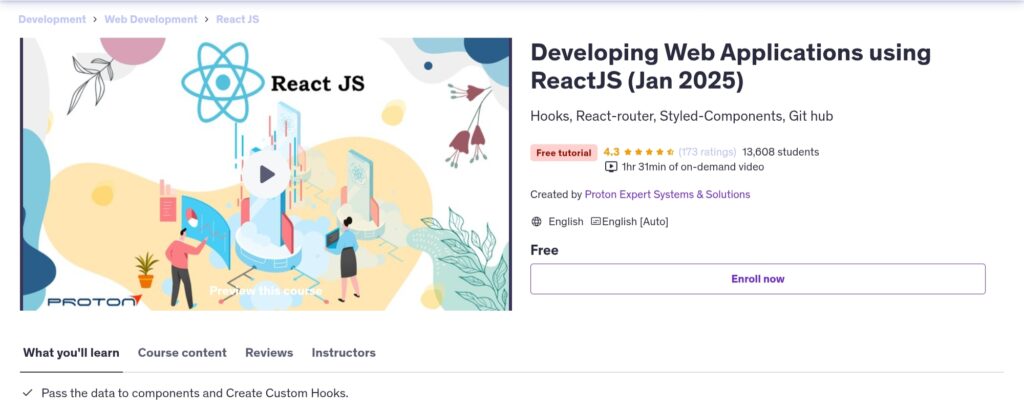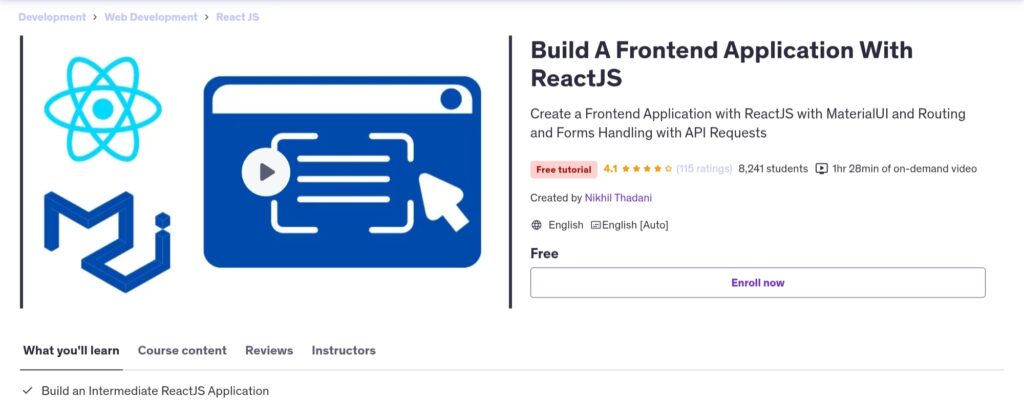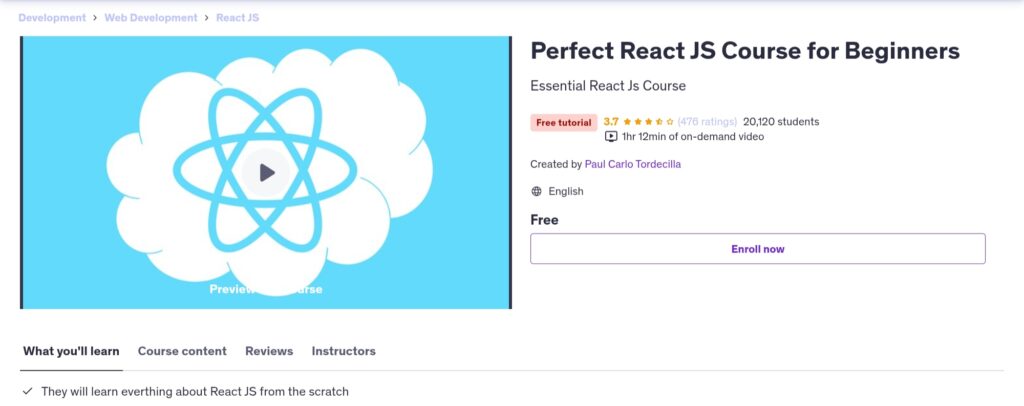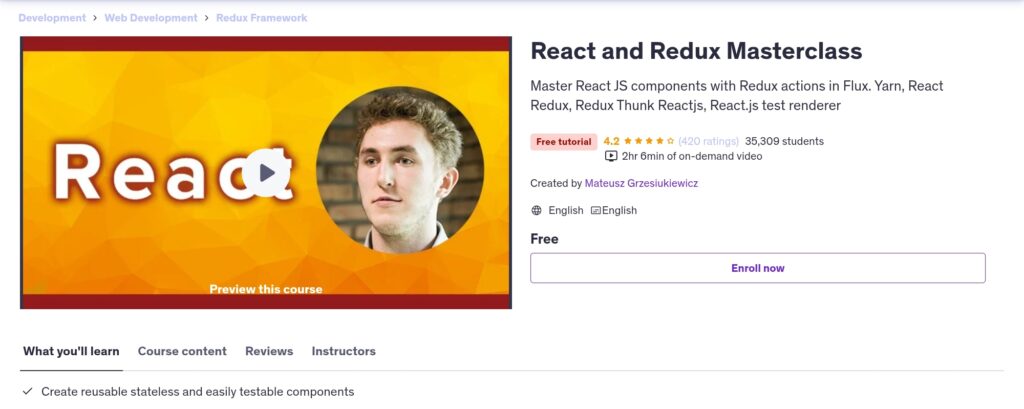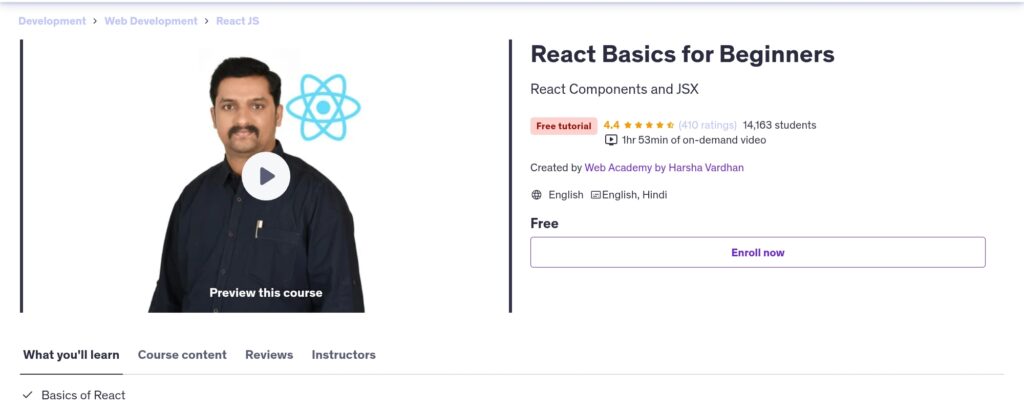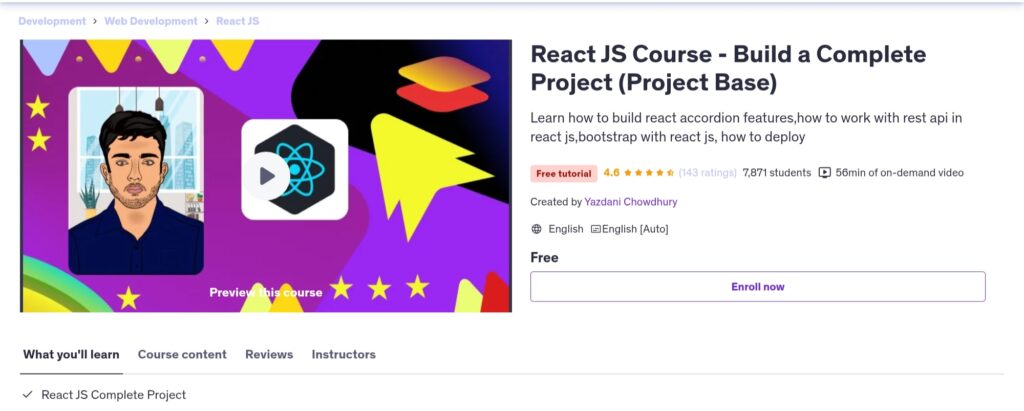After ten years of experience in content strategy, I’ve discovered that most individuals take the wrong approach to free courses. They bookmark everything, finish nothing, and gather them like virtual awards. React, however, is distinct.
The JavaScript library turns concepts into interactive experiences, drives the programs you use on a daily basis, and is essentially what gets you employed.
Udemy’s free React courses are purposefully lacking in order to impart fundamental knowledge, yet pique your interest in more complex abilities. It’s a smart business move, but here’s the inside scoop: newbies actually benefit from that incompleteness.
You’ll gain enough knowledge to comprehend contemporary JavaScript trends, create your first interactive elements, and—above all—determine whether coding is suitable for you or not.
Think of these courses as a React dating profile. These are coffee dates, not marriage proposals. It’s the ideal approach to find out if you and React development are clicking. Low commitment, high potential.
Some will squander your time with dull examples and out-of-date syntax. Others will have you thinking like a developer and creating real projects in a matter of hours.
Are you prepared to distinguish between the digital noise and the real learning opportunities? Let’s examine which free React courses on Udemy are worthwhile and which you ought to stay away from entirely.
Why Learn React in 2025?
In the highly competitive digital scene of 2025, React is not only surviving but also taking the lead. Developers with expertise in the library and its ecosystem are constantly in demand as major corporations continue to make significant investments in React-based applications.
Having observed the rise and fall of frameworks over the last ten years, I can say that React’s resilience stems not only from its core library but also from its ecosystem’s expansion.
The truth is revealed by the hiring market. Because they are ecosystem specialists who are knowledgeable about the entire modern web stack, React developers fetch high wages.
Businesses require developers who can use Vite for blazingly quick development builds, handle complicated state with Redux Toolkit, design React Query for effective data fetching, and smoothly integrate Next.js for server-side rendering.
Because of this ecosystem richness, React employment frequently pays 20–30% more than positions using standard JavaScript.
Your starting position is the only factor that affects your learning curve. React clicks in a matter of weeks if you are already familiar with the basics of JavaScript, including variables, functions, DOM manipulation, and ES6+ capabilities.
Rather than fighting about syntax, you will spend time learning component thinking. However, the ascent is more difficult for complete novices because JavaScript ideas, React patterns, and contemporary tools all vie for cognitive resources at the same time.
Before working with React, the majority of accomplished self-taught engineers devote two to three months to learning the basics of JavaScript.
This is where the ideal bridge is made by Udemy’s free React courses. They’re positioned to confirm your learning path before you spend money on expensive courses, boot camps, or certification programs, but they’re not thorough enough to prepare you for the workforce.
Consider them your React compatibility test, a low-risk method to find out if JSX syntax and component-based thinking are easy or difficult to use. In order to gain momentum, astute students enroll in free Udemy classes.
Once they are certain that React programming fits with their objectives and preferred method of learning, they go on to more expensive, comprehensive programs.
How Udemy’s Free Courses Work
It’s important to comprehend Udemy’s “free tutorial” designation before beginning any learning process. Although Udemy’s free React courses offer lifetime access to materials, downloadable resources, and video content, they are far less feature-rich than their commercial equivalents.
As someone who has examined hundreds of course conversion funnels, I can tell you that free tutorials are purposefully made to attract leads since they offer you real value while demonstrating the instructor’s experience and teaching approach.
Many students find the certificate reality check to be rather challenging. There are no completion certificates offered by free Udemy courses. These certifications are available only in paid courses and can be added to job applications or LinkedIn profiles.
This is a purposeful commercial choice to encourage upgrades to paid content rather than a technical restriction. Since certificates of completion are validated learning investments rather than merely surfing, the platform makes it obvious that they are exclusive advantages for students who purchase courses.
While surfing free selections, quality signals turn into your survival gear. Seek out courses with at least 1,000+ students and 3.5+ ratings; this shows consistent value delivery over time.
Top 10 Free React Courses on Udemy
1. React Fundamentals
This short yet helpful course is designed for developers who know HTML, CSS, and JavaScript and want a simple introduction to React. It works best for people who wish to quickly understand the main ideas without committing to a longer course.
Its attractiveness stems from the fact that it is a concise beginning point, ideal for JavaScript developers who prefer orientation to a thorough exploration of React.
How long does it take to complete?
This course provides an effective learning experience with only one hour and two minutes of on-demand video content. The essential content can be covered in approximately an hour, which makes it perfect for people with busy routines or those seeking a brief introduction to React basics.
What concepts are taught in this course?
React elements, JSX syntax, components, props, state, lifecycle functions, and container patterns are among the fundamental React principles covered in the course.
Additionally, you will study React Router version 4, conditional rendering, and forms and input handling. It even goes over how to set up a React environment so that students can follow along practically.
Why does this course stand out?
This tutorial’s greatest virtue is how concise it is, covering important React principles in an easy-to-understand manner. It’s ideal for introducing React gradually without requiring the commitment of a more extensive course.
React Router v4 is another advantage, exposing students to real routing processes at an early stage of their learning process. It’s an excellent “first look” at the React ecosystem because of how easy it is to put up and how clear the themes are.
Gaps to Watch
This course has aged in certain ways, despite its advantages. React Router V4’s usage indicates that it hasn’t been updated to more recent versions; React Router v6 is now the most recent.
In a similar vein, new tools like Vite or React Router v6+, functional components using useState and useEffect, and updated approaches like hooks are not mentioned.
Furthermore, learners who are looking for practical projects or deeper conceptual memory may find it too superficial due to its brevity.
2. Developing Web Applications using ReactJS
This course provides a brief, practical introduction to creating React single-page applications and is intended for front-end developers, full-stack developers, and software engineers who are at ease with JavaScript, HTML, and CSS.
It is especially well-suited for individuals seeking a hands-on, project-based introduction to React ideas, particularly those who wish to learn how to organize user interfaces, handle state, interact with forms, and use routing to move between views.
How long does it take to complete?
About 1 hour and 31 minutes of on-demand video footage are included in the course. This length makes it perfect for those who want a concentrated, less than two-hour in-depth study of React basics.
What concepts are taught in this course?
Writing JSX and configuring the development environment are two of the fundamental React patterns and functionalities you will master. Class and functional components, state management (state and setState), lifecycle methods, props, fragments, list keys, and higher-order components are all covered in the course.
Additionally, a lot of attention is paid to hooks, including custom hooks, managing form input, handling HTTP GET and POST requests, conditional rendering, styling components using Styled-Components, and routing with React Router.
Why does this course stand out?
The primary benefit of this course is its scope; it covers a large number of fundamental React features in a brief amount of time, making it a useful orienting tool.
A more comprehensive knowledge of React’s development is provided by the incorporation of both class-based and functional components. Interestingly, custom hooks—a characteristic that students frequently meet in more complex curricula—are also covered.
Furthermore, there is strong learner engagement indicated by the 4.3/5 rating (out of 173 ratings) and the more than 13,600 enrolled students.
Gaps to Watch
The course has evidence of partial obsolescence despite its positive attributes. Although hooks are present, the existence of lifecycle methods, class components, and React Router might not be in line with contemporary best practices, which prioritize hooks, functional patterns, and up-to-date router versions (such as React Router v6 and up).
Updates for the newest React features (such as concurrent features or server components) are not shown. Furthermore, the course description suggests a more theoretical presentation rather than supervised app-building and makes no mention of actual projects or deliverables. Lastly, even though the number of students is robust, it is small in comparison to more extensive, longer React courses.
3. React JS Frontend Web Development for Beginners
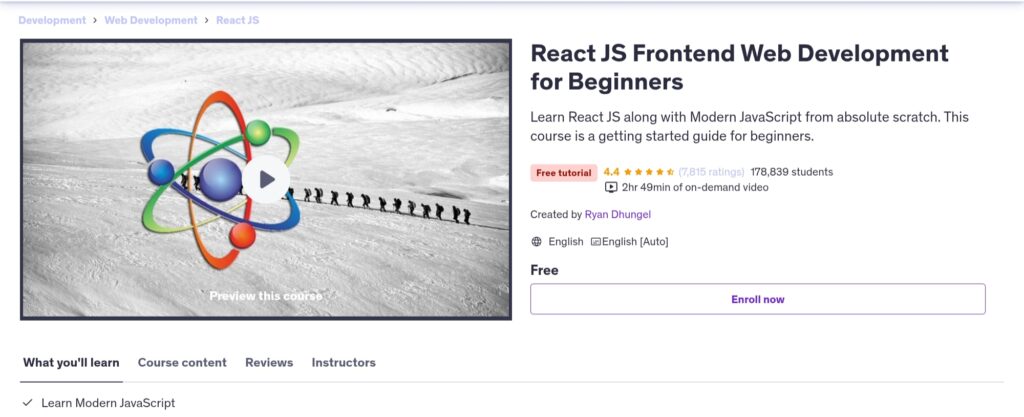
This course is specifically made for complete novices, or those who may know the basics of JavaScript but haven’t yet explored React. It’s perfect for students looking for a straightforward, practical introduction that lays a foundation in both the principles of React and contemporary JavaScript.
This course is a great place to start if you want to gradually get into creating React apps rather than jumping right into complex patterns or tooling.
How long does it take to complete?
The course is brief—just two hours and forty-nine minutes of on-demand video—but it covers a lot of topics. It’s ideal for time-pressed students who want a thorough introduction to React—enough time to practice using hooks, API calls, and creating a small project without becoming overly committed.
What concepts are taught in this course?
After a brief overview of contemporary JavaScript, you will quickly dive into the fundamentals of React. React Hooks, creating simple components, managing AJAX queries, and rendering data from external APIs are all covered in the course.
The guided method for developing a news app is a particularly powerful element that provides students with a concrete outcome to ground their comprehension.
Gaps to Watch
Despite the course’s dependability and beginner-friendliness, there are a few noteworthy limitations. Advanced React features like context API, state management libraries like Redux, and React Router are not covered.
Although the News App is a fantastic place to start, students looking for more complex, varied projects may find it restrictive due to its relative simplicity.
This course’s restricted emphasis, in contrast to longer tutorials or whole curricula, makes it ideal for short-term gains but inadequate for developing strong, scalable React skills on its own.
4. Build A Frontend Application With ReactJS
This course is designed for students who want to advance by creating a useful, intermediate-level application and who already know the fundamentals of ReactJS.
It is designed for students who are ready to solidify their foundation with practical project work, especially in the areas of React routing, form handling, and Material-UI API interactions.
It is perfect for hands-on learners. This lesson is ideal if you want to reinforce React concepts without having to start from scratch by creating a single, unified application.
How long does this course take to complete?
With an on-demand video duration of roughly one hour and twenty-eight minutes, this course effectively balances brevity and depth. For students who are strapped for time and want to make significant progress quickly, the course is particularly doable because it can be completed in a single session.
What concepts are taught in this course?
This course explores a number of fundamental React development topics. React Hooks and components, content-driven React routing, Material-UI for UI building, interactive form handling, and API calls for backend connectivity are all things you’ll come across.
It gives you the tools to retrieve data (converting responses into JSON) and incorporate it into functional, stateful React components.
Why does this course stand out?
The clear, project-centric approach is its main strength; bringing forms, routing, UI elements, and API interactions together creates a genuine mini-project experience.
The incorporation of Material-UI offers important insights into effectively designing an interface of professional quality. The course exhibits traction and learner satisfaction, as evidenced by its respectable 4.1/5 average rating and more than 8,200 enrolled students.
Gaps to Watch
However, there are several noteworthy restrictions. The pace of the course may be too fast for actual novices, as it assumes an existing React background.
Additionally, more complex React patterns like context, Redux, testing, or React Router v6 features aren’t covered, even though Material-UI and fundamental API interaction are.
One medium-complexity project is probably the focus of the course; therefore, students who want more exposure to different project types or a wider range of projects may need to augment their education elsewhere.
5. Perfect React JS Course for Beginners
This course is designed for complete novices who want an extremely approachable introduction to React and have a basic understanding of HTML, CSS, and JavaScript.
It particularly appeals to students who are eager to learn by doing—those who are inspired by practical coding tasks and an early introduction to the fundamental ideas of React.
It seems to be best suited for people who would rather get right in with real-world examples than theory-heavy education, based on its tone and format.
How long does this course take to complete?
This lesson is short—about an hour and twelve minutes of on-demand video—and perfect for those who want a quick, basic rundown rather than a thorough exploration.
What concepts are taught in this course?
The course covers the fundamentals of React with an emphasis on application. Inline styling, state initialization, parent-child components, conditional rendering, multiple components, event handling (onClick, onChange), standalone files, DOM element rendering, real-time app examples, and interactive features like increment counters will all be covered. A lot of focus is on “95% hands-on coding.”
Why does this course stand out?
Its interactivity and accessibility are its greatest assets. For people who learn best by coding right away, this course offers a very hands-on, beginner-first experience.
According to active learning methods, the instructor’s pledge of “95% hands-on coding” enables pupils to rapidly develop concrete comprehension. It obviously appeals to a novice audience, as indicated by its 3.7/5 rating and more than 20,000 enrolled pupils.
Gaps to Watch
It is important to note a few limitations, though. Due to speed or depth, the grade of 3.7/5 indicates mixed reviews. Modern React methods such as component testing, context API, React Router v6+, functional components with hooks, and project organization are not covered in the content.
It appears to focus on micro-examples rather than creating a comprehensive or production-like application. The comparatively brief time frame can also leave students in need of additional in-depth instruction or supervised project work to develop practical skills.
6. React Clarified: ‘Thinking in React’
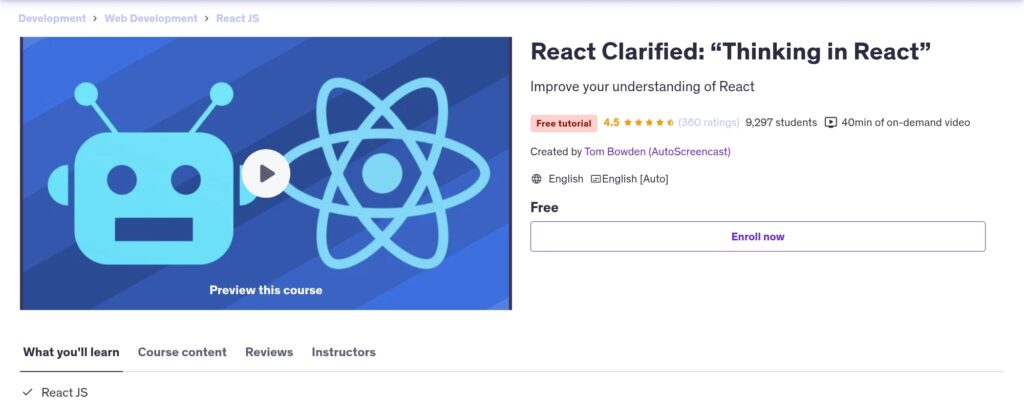
The purpose of “React Clarified: ‘Thinking in React’” is to assist developers who have dabbled in React and wish to strengthen their conceptual foundation. It’s particularly helpful for students who may understand React mechanics but find it difficult to successfully construct user interfaces using React’s declarative approach.
This brief, screencast-based course clarifies React for those who have “dabbled in it before but have some difficulties understanding it” by guiding you through the mental architecture of React interfaces used by seasoned developers.
How long does this course take to complete?
This 40-minute on-demand video course is incredibly condensed, making it ideal for a fast, fundamental reset when your learning stall is caused by muddled thinking rather than a lack of material.
What concepts are taught in this course?
The main goal of the content is to demystify the process of designing user interfaces in React. The course covers how to manage state, create clean UI logic, and deconstruct user interfaces into their component parts.
It is based on the “Thinking in React” philosophy found in the official React documentation. It prioritizes cognitive clarity above combining general functionalities. Therefore, there isn’t a practical project but rather a guided mentality change to help you create UIs using React more naturally.
Why does this course stand out?
The intellectual focus of the course is its most notable strength. It addresses a common source of dissatisfaction for many trainees by focusing on developing a clearer mental foundation for React programming rather than teaching new syntax or tools.
Strong satisfaction with the course’s clarity and usefulness is reflected in the 4.5 out of 5 rating, which is backed by more than 360 student ratings and around 9,300 enrollments.
Gaps to Watch
The scope of this tutorial is constrained; it doesn’t go into great detail about React Router, state management, hook usage, or component architecture principles. It is assumed that you are already familiar with the fundamentals of React structure and hooks, particularly useState.
This course is better seen as a mental model booster than as a stand-alone learning unit if your goal is to develop real-world applications or seek out practical experience.
7. React and Redux Masterclass
This course is well-suited for developers who already grasp JavaScript (with ES6), React principles, and the need for scalable architecture. If you are someone who seeks to develop maintainable, tested React applications, this course offers clear value—especially for those wishing to go beyond surface-level lessons.
It is especially useful for students who are already familiar with Redux and React but wish to learn how to use reducers and stateless, reusable components to decouple logic.
How long does it take to complete?
With around 2 hours and 6 minutes of content, this course offers a concise, targeted deep dive. It’s meant as a targeted upskill rather than a full, extensive program—perfect for someone looking to enhance architectural expertise within a couple of hours.
What concepts are taught in this course?
Writing modular, reusable, and testable React + Redux code is the main focus of this tutorial. Building stateless components, creating pure reducers, integrating those views with container components, and refactoring for improved maintainability are all skills you’ll acquire. The learning process revolves around fundamental ideas like scalable code structure and Flux architecture.
Why does this course stand out?
Its architectural approach, which uses clean components and reducer design to meet real-world testing and scalability concerns, is its biggest strength.
Strong credibility is provided by the lecturer, Mateusz Grzesiukiewicz, who was once an Atlassian software developer and is the author of books and lectures centered on design patterns.
With over 35,000 enrolled students and an amazing 4.2/5 rating from 420 ratings, the course is clearly popular among students who want to learn more about deeper design thinking.
Gaps to Watch
This is not a course for complete novices. It assumes a basic understanding of ES6 and React. Furthermore, even though its architectural perspective is useful, it could come across as abstract due to the absence of practical application-building or user interface-focused examples.
This section might need to be combined with other, more practical or updated tutorials for learners looking for projects, routing, hooks, or contemporary Redux Toolkit patterns.
8. React Basics for Beginners
This free lesson is designed for complete novices who wish to get started with React and are familiar with the fundamental web technologies HTML, CSS, JavaScript, and Bootstrap.
For students who want a succinct and understandable introduction without delving into expensive courses or difficult ideas, it’s perfect. This course is a useful place to start because of its clarity and simplicity.
How long will this course take to complete?
The course is roughly one hour and fifty-three minutes of on-demand video and provides a concise but insightful overview of React’s fundamental ideas without being too demanding for novices.
What concepts are taught in this course?
The basics of React will be covered, including what React is, how to create a React application, how to build components, how to render data inside components, and how to use the Virtual Document Object Model. Additionally, the course demonstrates how to change component state and load Bootstrap into a React environment.
Why does this course stand out?
Its accessibility and conciseness are its strongest points. It is a true zero-commitment introduction, with a short runtime of less than two hours. In order to effectively serve students throughout India, the course is offered in both Hindi and English. Its success as a beginner-level tutorial is further supported by the fact that over 410 students gave it a strong 4.4 out of 5 rating.
Gaps to Watch
A few essential components are missing from this course, as is to be anticipated with brief, free content. It lacks interactive assignments, practical projects, and Q&A access, which are features only available in expensive courses.
Additionally, missing are contemporary React concepts like routing, context, functional components, hooks, and sophisticated tools. Learning is still primarily theoretical with little real-world application.
9. React JS Course – Build a Complete Project (Project Base)
This course is designed for absolute novices who want to roll up their sleeves and create something tangible immediately. This is a wonderful place to start if you’re new to React and prefer practical learning to theory.
No prior knowledge of React is required; in fact, even for individuals who are unfamiliar with frontend development, the course guarantees accessibility and hands-on learning.
How long does it take to complete?
The course’s information is presented in a concise and targeted 56-minute on-demand video. Because of its short runtime, it’s perfect for people who don’t have much time or who would rather start developing right away.
What concepts are taught in this course?
The course covers the following topics as it guides you through creating a comprehensive React project from beginning to end.
- State and logic management with React Hooks
- Obtaining and presenting API data
- Building an accordion user interface in React
- Using Bootstrap to create responsive designs
- Making Use of React Icons
- Using both bespoke and inline CSS for styling
- Data transfer between components
- Steps for customizing the domain and deploying the completed application to Netlify
Why does this course stand out?
Its practicality is its greatest strength. In less than an hour, learners create a completely functional app that includes UI elements, API integration, style, and deployment.
You end up with a live, shareable product, which is an instant real-world payoff. Nearly 7,900 students have enrolled in the course, and 143 students have given it a strong 4.6 out of 5 rating, which is significant evidence of its efficacy and popularity.
Gaps to Watch
There are unavoidable limits because of its conciseness and beginner-focused focus. Modern React approaches like React Router, sophisticated hooks patterns, Context API, and state management strategies like Redux or Redux Toolkit are not covered in the course.
It also lacks more in-depth architectural supervision and a wider range of projects. Additionally, its cadence could seem hurried to people who prefer thorough explanations to quick development.
10. React Fundamentals – The Complete Guide For Beginners
This course is intended for developers who have never worked with React before but are familiar with the fundamental web technologies such as HTML, CSS, and JavaScript.
It’s especially appropriate for people who want to learn React from the ground up under precise, methodical instruction. In conclusion, students ought to be at ease building simple React apps.
How long does it take to complete?
This is a brief and easily assimilated introduction, consisting of around 1 hour and 33 minutes of on-demand video content. It is an excellent low-commitment starting point because it allows determined learners to acquire a thorough overview of React fundamentals in a single sitting.
What concepts are taught in this course?
Starting with the setup of your first React application, the curriculum covers both functional and class-based components before delving into fundamental concepts like state, props, JSX, hooks, and interacting with external APIs.
It also discusses DOM manipulation and component architecture in general, giving a fair rundown of React’s fundamental building blocks.
Why does this course stand out?
This course’s main advantages are its accessibility, organization, and clarity. Abdelmouiz Kerim gives students a clear and straightforward introduction to the ecosystem by presenting React essentials in a very focused way.
His experience instructing novices via several React and web development courses confirms that the course is suited to their needs. Nearly 4,900 enrolled students and a 4.2/5 rating (based on about 82 evaluations) point to strong learner engagement and satisfaction.
Gaps to Watch
Although the fundamentals of React are well introduced in this course, there are some obvious drawbacks. Advanced or contemporary patterns like React Router (particularly v6), Context API, Redux or Redux Toolkit, testing, and contemporary build tools like Vite are not covered.
It focuses on teaching the fundamentals rather than production-level architecture or full-stack applications. Furthermore, the comparatively low rating in comparison to other longer-form React courses suggests that some students might find the information to be superficial.
Comparison Table
| Course | Level | Duration | Last Updated | Core Topics (Hooks, Router, State Mgmt) | Projects / Assignments | Certificate? | Best For |
| React Fundamentals | Beginner | 1 hrs 2m | 2023 | Components, JSX, Hooks basics | Small practice apps | No | Learners new to React basics |
| Developing Web Apps using ReactJS | Beginner–Intermediate | 2 hrs 39m | 2023 | JSX, Components, Props, State | Mini web app examples | No | Beginners exploring real-world React apps |
| React Tutorial | Beginner | 1 hr 19m | 2023 | Components, Props, JSX, Hooks | Guided examples | No | Fast intro to React for complete beginners |
| Frontend Development with React | Intermediate | 2 hrs | 2023 | Components, State, Hooks, APIs | Small demo projects | No | Web devs adding React to their toolkit |
| Perfect ReactJS Course | Beginner | 2 hrs 18m | 2023 | JSX, State, Props, Functional Components | Simple assignments | No | Quick start learners who prefer concise tutorials |
| React Clarified: Thinking in React | Beginner | 56m | 2023 | Component hierarchy, State handling | “Thinking in React” practice | No | Beginners who want conceptual clarity |
| Learning React & Redux with Stateless Components | Intermediate | 1 hr 14m | 2023 | Redux basics, Stateless Components | Hands-on Redux examples | No | Learners who want early exposure to Redux |
| React Basics for Beginners (JavaScript) | Beginner | 1 hr 8m | 2023 | JSX, Props, Hooks basics | Example-driven | No | JavaScript beginners testing React waters |
| React JS Course – Build a Complete Project | Beginner–Intermediate | 2 hrs 11m | 2023 | State, Props, Components, Hooks | Complete mini project | No | Learners who prefer project-based learning |
| React Fundamentals – The Complete Guide for Beginners (by Abdelmouiz Kerim) | Beginner | 1 hr 33m | 2023 | State, Props, Hooks, API calls | Intro projects | No | Complete novices seeking structured fundamentals |
Conclusion
Udemy’s free React courses are more than just inexpensive substitutes; they serve as useful springboards for your development profession. I’ve helped innumerable developers on their learning paths, and I’ve witnessed how the correct free course can lead to that pivotal change in mindset from “maybe I should learn to code” to “I need to build something real with this.“
When you start creating instead of consuming, the magic happens. Avoid the tutorial trap, which is the never-ending loop of watching more videos without creating anything, after finishing any good free React fundamentals course.
Instead, start working on two or three modest projects right away: a weather app that pulls actual API data, a basic to-do app with local state, and a personal portfolio website. Your learning is more solidified by these projects than by taking ten more classes.
Completing the free course is just the first step, not the last. Employers expect route management proficiency, and current web apps require navigation.
Therefore, learning React Router v6 will become your next vital skill. When your applications get too complex for straightforward use, Redux Toolkit comes in handy.
State tendencies require consistent state administration. By teaching you how to design tests that do more than just check boxes, the React Testing Library completes your professional arsenal.
The truth about careers is as follows: Hiring managers assess your abilities to create, test, and launch real applications, while free React courses verify your interest and teach fundamental ideas.
Make use of these free courses to validate your knowledge and boost your confidence. Next, make a calculated investment in paid, all-inclusive programs that contain advanced projects, certifications, and the ecosystem depth necessary to turn enthusiasts into employable React developers.
Although you can begin your React journey for free, you will need to invest in abilities that will set you apart from the thousands of other developers who stopped at basic tutorials if you want to advance in your career.
FAQ
Are these courses really free?
Yes, it is truly free and has no trial periods or additional fees. Free React classes on Udemy give users lifetime access to course materials, downloadable resources, and video content without asking for payment details. When Udemy claims to be free, they mean it. There are no credit card gimmicks or automatic upgrades.
Do I get a certificate?
Not at all. No completion certificates are ever included in free Udemy courses. Certificates from paid courses are the only ones you may show employers or add to your LinkedIn profile.
This is a deliberate business approach; certificates stand for validated learning investments rather than pointless perusing. You will need to upgrade to paid courses or pursue other certification options if you require credentials for employment applications.
Will a free course get me job-ready?
Fundamentals, not employability skills, are taught in free courses. They go over the fundamentals of React, such as components, props, and state, but they exclude important work requirements, such as deployment, testing, routing, and API integration.
Consider free courses as tools for skill validation; they let you determine whether React development is something you want to pursue before spending money on in-depth instruction. Six to twelve months of focused study, including advanced patterns, real-world projects, and portfolio development, are necessary to prepare students for the workforce.
Any legal ways to access paid Udemy courses for free?
Gale Presents: Udemy through public library systems offers the most reliable free access to premium course catalogs — check your local library’s digital resources.
Premium material becomes inexpensive during promotional periods when monthly Udemy promotions bring course costs down to ₹455–₹799. Through university agreements, educational institutions occasionally grant students free access to Udemy Business.
Share Now
Related Articles
11 Best React Courses and Certifications for Developers (Updated 2025)
React vs React Native: The Difference You Need To Know
Top 10 JavaScript Courses on Coursera
Discover more from technicalstudies
Subscribe to get the latest posts sent to your email.


